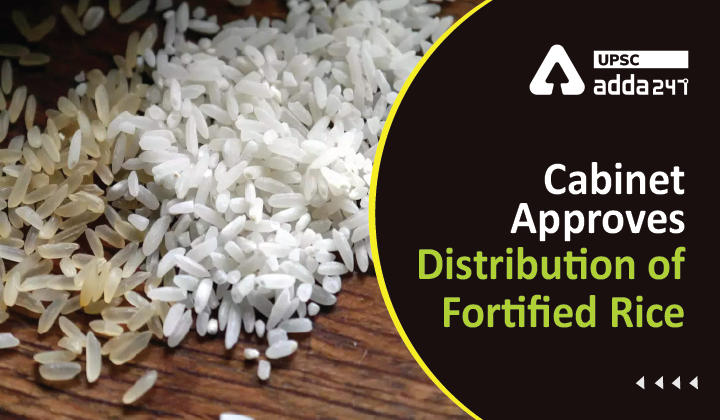Table of Contents
Rice fortification UPSC: Relevance
- GS 2: Welfare schemes for vulnerable sections of the population by the Centre and States.
Rice fortification in India: Context
- Recently, Cabinet Committee on Economic Affairs (CCEA) has approval for supply of fortified rice through various government schemes by 2024.
Rice fortification: Key points
- Rice fortification has been targeted for the below mentioned schemes:
- Targeted Public Distribution System (TPDS) under the National Food Security Act (NFSA)
- Integrated Child Development Services (ICDS)
- Pradhan Mantri Poshan Shakti Nirman-PM POSHAN [erstwhile Mid-Day Meal Scheme (MDM)]
- Other Welfare Schemes (OWS) of Government of India in all States and Union Territories.
- The entire cost of rice fortification (around Rs. 2,700 crore per annum) would be borne by the Govt. of India as part of food subsidy till its full implementation upto June, 2024.
Rice fortification: Three phases
- Phase-I: Covering ICDS and PM POSHAN in India all over by March, 2022 which is under implementation.
- Phase-II: Phase I above plus TPDS and OWS in all Aspirational and High Burden Districts on stunting (total 291 districts) by March 2023.
- Phase-Ill: Phase II above plus covering the remaining districts of the country by March 2024.
Rice fortification India
- In the Independence Day speech, our PM made an announcement on Fortification of Rice so as to provide nutrition to every poor person of the country to overcome malnutrition and lack of essential nutrients in women, children, lactating mothers etc. as it poses major obstacles in their development.
- Earlier, the Centrally Sponsored Pilot Scheme on “Fortification of Rice and its Distribution under Public Distribution System” was implemented for a period of 3 years beginning from 2019-20.
What is rice fortification?
- According to Food Safety and Standards Authority of India (FSSAI), it is deliberately increasing the content of essential micronutrients in a food so as to improve the nutritional quality of food and thus improve public health.
- Fortification of rice is a cost-effective and complementary strategy to increase vitamin and mineral content in diets.
Rice fortification need
- High levels of malnutrition among women and children in the country.
- According to the Food Ministry, every second woman in the country is anaemic and every third child is stunted.
- India ranks 94 out of 107 countries and is in the ‘serious hunger’ category on the Global Hunger Index (GHI).
What are the added nutrients?
- According to FSSAI norms, 1 kg fortified rice will contain
- iron (28 mg-42.5 mg),
- folic acid (75-125 microgram)
- Vitamin B-12 (0.75-1.25 microgram).
- In addition, rice may also be fortified with micronutrients, singly or in combination, with zinc and vitamin B.
Rice fortification: Steps taken so far
- The Ministry of Consumer Affairs, Food and Public Distribution launched a centrally sponsored pilot scheme in 2019-20 on ‘Fortification of Rice and its Distribution under PDS’ for a period of three years.
- The pilot scheme focuses on 15 districts in 15 states – Andhra Pradesh, Kerala, Karnataka, Maharashtra, Odisha, Gujarat, Uttar Pradesh, Assam, Tamil Nadu, Telangana, Punjab, Chhattisgarh, Jharkhand, Uttarakhand and Madhya Pradesh.
- Six states, including Maharashtra and Gujarat, have started distributing fortified rice as part of the pilot scheme, with approximately 2.03 LMT of fortified rice being distributed till June 2021.
- Four more states are expected to start by September 2021.
- The Food Ministry says that from April 1, 2022, 250 high-burden districts are proposed to be covered under the rice fortification scheme.
Rice fortification: International Experience
- Seven countries have mandated rice fortification – USA, Panama, Costa Rica, Nicaragua, Papua New Guinea, Philippines and Solomon Islands.
Read current affairs for UPSC





 TSPSC Group 1 Question Paper 2024, Downl...
TSPSC Group 1 Question Paper 2024, Downl...
 TSPSC Group 1 Answer key 2024 Out, Downl...
TSPSC Group 1 Answer key 2024 Out, Downl...
 UPSC Prelims 2024 Question Paper, Downlo...
UPSC Prelims 2024 Question Paper, Downlo...




